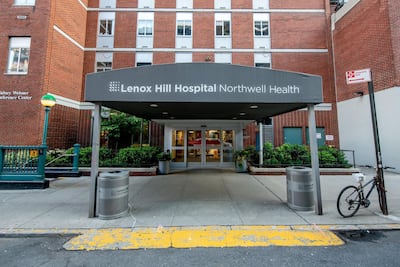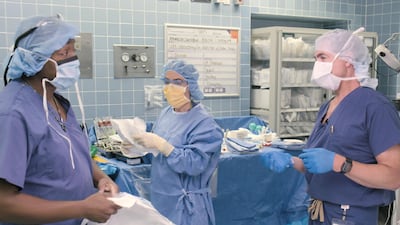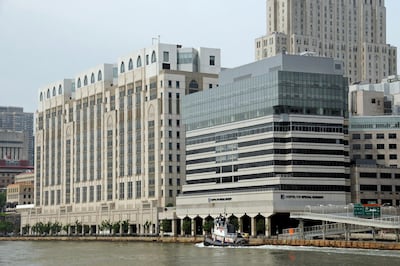It is an old chestnut to write about how America fails its citizens but the US is the only country where I have lived that doesn’t provide health care. It is the duality of a superpower that can spend a fortune on military hardware but cannot protect its most vulnerable people.
In France, I have a shiny green Carte Vitale – the card of the National Health Care Service. In the UK, I still have my old National Insurance card – red, pale blue, white – from the 1980s which granted me use of the National Health Service.
But when I arrived in America three years ago, the first thing I did was get a job that gave me insurance. Otherwise, I was told by everyone I knew, I could go bankrupt or be in debt my entire life if I broke a leg or got hit by a car.
Most people in the US have either private insurance or a combination of various state or federal programmes. But often these programmes don’t provide access to the best facilities. There is not much choice if you are poor: you take what you can get, which is why many poor people don’t go to the doctor.
There is also the question of dignity. Once, taking a sick relative on Medicaid – the nation’s public health insurance for people with low income – to a clinic, my sister overheard the doctor say to his nurse: “Give him no more than ten minutes. He’s on Medicaid.”
In the past five days, both my son and I were ill. We were treated in vastly different healthcare facilities. Yet both were excellent because of the compassion and dedication of the staff. Most nights during lockdown I leaned out of my window at 8pm and clapped, cheered and banged pans for the anonymous healthcare heroes saving lives. Now, in the past week, I know who they are.
My son had a serious mountain bike accident while we were on vacation in Wyoming. Although the “blood” wagon that brought him off the bike track, and the small emergency clinic were helpful, they could not do a complicated surgery. I had to haul my wounded child back to our home in New York City.
It was a long, painful journey, that could not have helped his broken bones. I struggled to soothe him and my own nerves at the same time.
Once back in New York, my private insurance card (generously provided by my employer) opened doors to the best orthopedic hospital in America to my son. One way to describe my son’s hospital is 'chic'.
The Hospital for Special Surgery was founded in 1863 for orthopedic woes. It is the official hospital of the New York Mets, Knicks, Giants and Red Bulls. It is ranked number one in the entire country, and many of the doctors travel to the Olympics with athletes.
The care was phenomenal – the skill and training of the surgeons, the concern of the nurses, the level of attention. At the same time, while I was grateful my boy was in good hands, I was guiltily aware that this is a hospital for the one-percenters.
The website says it does treat Medicare patients, but there is often a co-pay – or co-payment, where you pay a fixed amount for a health service. I don’t think Medicare is going to pay the hundreds of thousands of dollars spinal or other specialised surgery requires.
Nursing my son at home, unfortunately, I had my own medical mishap. A severe headache left me paralysed. I could barely walk. Frightened I had contracted Covid-19, I made my way to the neighbourhood walk-in urgent care. The doctor there was worried about my level of pain so she sent me straight to the emergency room or ER of Lenox Hill Hospital, which happens to be across the street from where I live.
For two years, Lenox Hill has annoyed me. I have lived with the constant sound of ambulances in the middle of the night. I come out my front door to jostle with doctors and nurses in scrubs smoking on their breaks. The Dunkin Donuts next door is always overcrowded with the staff, as is the Pick-a-Bagel.
But now I was their patient.
Lenox Hill is a legend in Manhattan, a doyenne of medical facilities. Built in the late 1800s by German doctors, it was renamed Lenox Hill in 1918, during the Spanish Flu pandemic.
In 2020, it was at the frontline of the coronavirus pandemic, receiving the first Covid-19 patient on March 7, and at one point treating nearly 300. Refrigerated trucks were lined up outside for the dead, and it became the symbol of the courage of healthcare workers worldwide.
Netflix made a documentary (called Lenox Hill) that follows the lives of four doctors and their patients, and which aired in June. The day I arrived at Lenox Hill, they were down to only two Covid-19 patients.
But the Lenox Hill ER was a far cry from the spotless corridors of the hospital for special surgery. Waiting for my son to emerge from his five-hour-long procedure, I sat in plush chairs with plenty of ports to plug in my computer and iPhone. A TV blasted CNN. There was a spiritual centre (for Muslims, Christians, Jews) and a Starbucks nearby.

The emergency room was full so I spent most of the day on a stretcher in a narrow corridor next to the laundry bins. Doctors, nurses, technicians and laundry workers who passed gaped down at me. It was a few days after Labour Day – the traditional end of US summer holidays – and for some reason, the place was insanely busy.
Still, I got all the care and tests I needed: a CAT scan, an MRI, a chest X-ray, a Covid-19 test (negative). In between, I lay on my stretcher and watched a stream of Victor Hugo-esque characters hobble through the door: injured, inebriated, homeless, delirious, bloody and wounded.
“To me, the ER is the front line,” Dr Mirtha Macri told Netflix in the first episode of Lenox Hill. “We take whoever, whatever… if you’re uninsured, if you’re insured, if you’re a criminal, anything you are, we put it to the side, and we just treat you.”
They all came through the door the day I spent in ER. The doctors and nurses treated everyone equally, patched them up, sent them for X-rays or gave them a sandwich and a ginger ale.
I compared them to the surgeons and nurses I met earlier at the Hospital for Special Surgery. Obviously, my respect and gratitude for patching up my broken son was huge. But it was these emergency doctors and nurses who were heroes to me. They had gone through the fire and survived. They had treated Covid-19 patients from the first day the virus hit Manhattan and they were still here.
I found it hard to imagine the trauma they had undergone these past few months, deciding who would be intubated, seeing patients die and living under the constant fear they would also catch the virus. They worked double shifts, ate doughnuts instead of proper meals and attended to patients for long, endless nights.
When they had a few moments for me, I was struck at their resilience and patience. They called me “honey” and “dear”. They never lost their tempers.
“Aren’t you tired?” I asked one of the nurses, who had come from Philadelphia during the pandemic to devote his services. He had been in the ER when I arrived at 8am. He was still there at 9pm.
“I forgot what tired is,” he replied cheerfully.
I stumbled out of the ER at night after 10 hours in the laundry room, bleary from medication and the many tests. My headache was nearly gone. The streets were dark, the ambulances double parked.
At home, my son was at his desk, his bones healing.
Before I went to sleep, I turned out my lights and looked across the road at Lenox Hill. The lights were on and inside, all night long, a parade of committed people were working. It made me feel safe. It made me feel better.
Janine di Giovanni is a Senior Fellow at Yale’s Jackson Institute for Global Affairs. Her last book is “The Morning They Came For US: Dispatches from Syria.”



